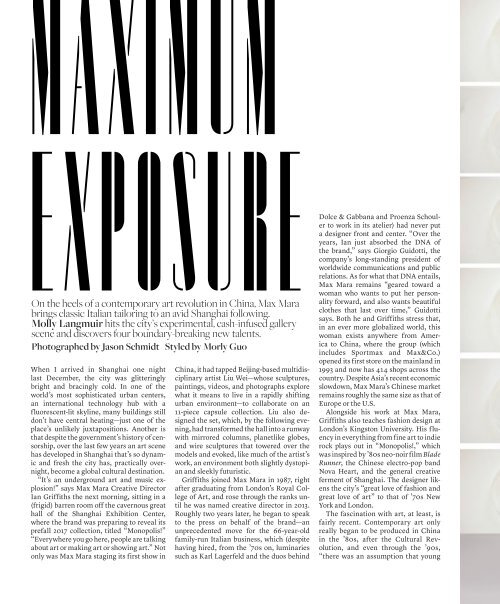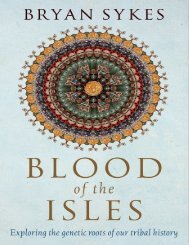You also want an ePaper? Increase the reach of your titles
YUMPU automatically turns print PDFs into web optimized ePapers that Google loves.
MAXIMUM<br />
EXPOSURE<br />
On the heels of a contemporary art revolution in China, Max Mara<br />
brings classic Italian tailoring to an avid Shanghai following.<br />
Molly Langmuir hits the city’s experimental, cash-infused gallery<br />
scene and discovers four boundary-breaking new talents.<br />
Photographed by Jason Schmidt Styled by Morly Guo<br />
When I arrived in Shanghai one night<br />
last December, the city was glitteringly<br />
bright and bracingly cold. In one of the<br />
world’s most sophisticated urban centers,<br />
an international technology hub with a<br />
fluorescent-lit skyline, many buildings still<br />
don’t have central heating—just one of the<br />
place’s unlikely juxtapositions. Another is<br />
that despite the government’s history of censorship,<br />
over the last few years an art scene<br />
has developed in Shanghai that’s so dynamic<br />
and fresh the city has, practically overnight,<br />
become a global cultural destination.<br />
“It’s an underground art and music explosion!”<br />
says Max Mara Creative Director<br />
Ian Griffiths the next morning, sitting in a<br />
(frigid) barren room off the cavernous great<br />
hall of the Shanghai Exhibition Center,<br />
where the brand was preparing to reveal its<br />
prefall 2017 collection, titled “Monopolis!”<br />
“Everywhere you go here, people are talking<br />
about art or making art or showing art.” Not<br />
only was Max Mara staging its first show in<br />
China, it had tapped Beijing-based multidisciplinary<br />
artist Liu Wei—whose sculptures,<br />
paintings, videos, and photographs explore<br />
what it means to live in a rapidly shifting<br />
urban environment—to collaborate on an<br />
11-piece capsule collection. Liu also designed<br />
the set, which, by the following evening,<br />
had transformed the hall into a runway<br />
with mirrored columns, planetlike globes,<br />
and wire sculptures that towered over the<br />
models and evoked, like much of the artist’s<br />
work, an environment both slightly dystopian<br />
and sleekly futuristic.<br />
Griffiths joined Max Mara in 1987, right<br />
after graduating from London’s Royal College<br />
of Art, and rose through the ranks until<br />
he was named creative director in 2013.<br />
Roughly two years later, he began to speak<br />
to the press on behalf of the brand—an<br />
unprecedented move for the 66-year-old<br />
family-run Italian business, which (despite<br />
having hired, from the ’70s on, luminaries<br />
such as Karl Lagerfeld and the duos behind<br />
Dolce & Gabbana and Proenza Schouler<br />
to work in its atelier) had never put<br />
a designer front and center. “Over the<br />
years, Ian just absorbed the DNA of<br />
the brand,” says Giorgio Guidotti, the<br />
company’s long-standing president of<br />
worldwide communications and public<br />
relations. As for what that DNA entails,<br />
Max Mara remains “geared toward a<br />
woman who wants to put her personality<br />
forward, and also wants beautiful<br />
clothes that last over time,” Guidotti<br />
says. Both he and Griffiths stress that,<br />
in an ever more globalized world, this<br />
woman exists anywhere from America<br />
to China, where the group (which<br />
includes Sportmax and Max&Co.)<br />
opened its first store on the mainland in<br />
1993 and now has 414 shops across the<br />
country. Despite Asia’s recent economic<br />
slowdown, Max Mara’s Chinese market<br />
remains roughly the same size as that of<br />
Europe or the U.S.<br />
Alongside his work at Max Mara,<br />
Griffiths also teaches fashion design at<br />
London’s Kingston University. His fluency<br />
in everything from fine art to indie<br />
rock plays out in “Monopolis!,” which<br />
was inspired by ’80s neo-noir film Blade<br />
Runner, the Chinese electro-pop band<br />
Nova Heart, and the general creative<br />
ferment of Shanghai. The designer likens<br />
the city’s “great love of fashion and<br />
great love of art” to that of ’70s New<br />
York and London.<br />
The fascination with art, at least, is<br />
fairly recent. Contemporary art only<br />
really began to be produced in China<br />
in the ’80s, after the Cultural Revolution,<br />
and even through the ’90s,<br />
“there was an assumption that young

















